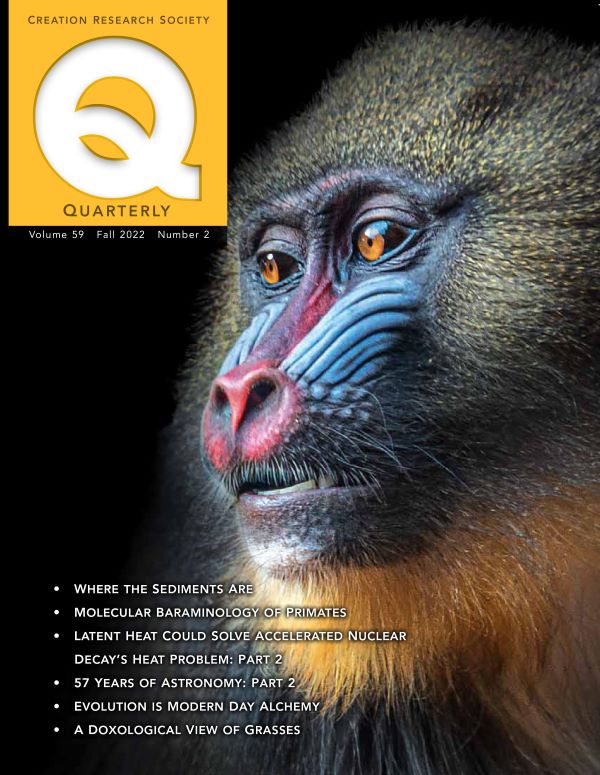
ABSTRACTS
Molecular Baraminology of Primates
Matthew Cserhati
Twenty-six species of primates were examined by the Gene Content method, and 93 mitochondrial genome sequences were downloaded from the NCBI database, aligned, and analyzed. In total, 96 species were studied, about half of all primates. The Gene Content method predicts at least six putative primate holobaramins: cercopithecines, colobines, New World monkeys, lemurs, great apes, and humans. The mitochondrial DNA analysis predicts sixteen groups, which are likely monobaraminic lineages within the groups predicted by the Gene Content method. This study predicted a larger number of groups compared to a previous study of primates and other vertebrates. Interestingly, examination of the newly sequenced mitochondrial genome of Homo heidelbergensis places it within the human holobaramin, in agreement with previous studies that included it based on morphological data alone. The human holobaramin also clearly separates from all other primate species, even its alleged closest relatives, the great apes. Hylobatidae is possibly a seventh primate group, and Pongo (orangutan) is a possible eighth group.
Fifty-Seven Years of Creation Astronomy Part II: Issues and Advances
Andrew Repp
A significant quantity of creation astronomy work has appeared since the launch of CRSQ. A previous article analyzed the breadth and diversity of this work. The present article complements the former by examining some of the issues raised by this literature. It first notes the importance of methodological precision (e.g., mindfulness of the distinction between mixed questions and science per se); second, it identifies major unresolved issues (light-travel time, the cosmic microwave background, and star-formation/development); and third, it notes areas of significant progress (exploration of the light-travel time issue and a nascent young-Earth model for Solar-System history).
Latent Heat Could Solve Accelerated Nuclear Decay’s Heat Problem—Part II
Barbara S. Helmkamp
I n Part 1, a phase change for the condensed matter comprising large nuclei was proposed as a heat sink during an episode of accelerated nuclear decay, being particularly relevant to the formation of radiohalos. The proposed nuclear phase change would occur in 206Pb nuclei, being the final stable progeny in the 238U decay chain. With each cascade of decays, the latent heat for this presumed first order phase transition would be taken from (via heat transfer, generically invoked) and thereby continuously cool the radio-center’s immediate environment wherein the thermal energy is deposited. Arguing by analogy with atomic/ molecular systems, the plausibility of providing sufficient cooling (absorbing enough energy) by a phase change is explored: latent heat of an MeV per alpha cluster for arguably 41 alpha clusters in lead’s nucleus is roughly commensurate with the 43.7 MeV of heat produced in stopping the eight alpha particles emitted in the uranium decay series. The lower entropy phase for large, unstable nuclei during accelerated decay might consist of alpha clusters as compared with primarily nucleon pairings for the normal phase. The nuclear phase change would occur with/at the switch from unstable parent isotope to stable daughter in accordance with the dependence of a hypothetical nuclear phase diagram on the decreased strength of the nuclear force (a shallower nuclear potential) for unstable nuclei characterizing an episode of accelerated decay as compared with normalcy.
Where the Sediments Are
John K. Reed, Michael J. Oard, Peter Klevberg
Confidence in forensic natural history increases when data are simple, observable, and complete. Larger scale often helps. For continental sedimentary rock and marine sediments, the best combination of these factors would be found in assessing their global volume and distribution. Geologists developed estimates long ago, but only in recent decades have database and mapping technology combined to allow reasonably accurate global maps of continental and marine sediment. Just recently, a good estimate of the volume and average thickness of the ocean sediments became available through the GlobSed project. The volume and thickness of the continental sediments is more difficult to describe for several reasons; defining the continent-ocean boundary is one. Defining Precambrian sedimentary basins and their relationship to the Genesis Flood adds uncertainty, but the goal of defining the global distribution of Flood sediments is worth pursuing.
